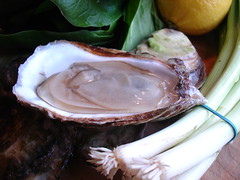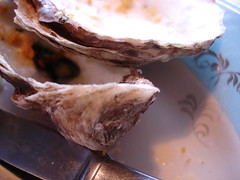The Raw and the Baked
 fig. a: before
fig. a: before
I'd always assumed that the origins Oysters Rockefeller had some kind of direct association with ole John D. himself--something to the effect of Mr. Rockefeller having requested a special oyster dish from a favorite chef, or some chef having created a special oyster dish in Rockefeller's honor for some high society dinner. Apparently I was wrong. As James Beard and others have pointed out, there are numerous, if not countless, variations on Oysters Rockefeller, but most trace the dish's origins back to New Orleans at the turn of the 20th century and Mr. Jules Alciatore. Mr. Alciatore was the owner of the legendary Antoine's restaurant and the son of its founder, and around 1899 he began to serve his patrons a baked oyster dish with a tantalizingly buttery herb topping. The dish was a sensation and it was quickly added to Antoine's Pantheon, alongside such classics as Tomato Frappée Julius Caesar, Terrapin St. Anthony, and Toast Rothschild. It too needed a dignified name, something that would fully capture its majesty--who better to name one's rich new oyster hors d'oeuvre after than America's reigning oil magnate? Duly named, Alciatore's dish was reintroduced to Antoine's menu: "Huîtres en Coquille Rockefellow." [I guess it could have been worse--he could have named it "Huîtres en Coquille Roc-A-Fella."]
Its name corrected, Oysters Rockefeller soon traveled far beyond New Orleans, becoming a nationwide hit, but with the original recipe a closely guarded "sacred family secret," it didn't take long for the dish to morph into countless variations. For the most part Alciatore kept mum about the impostors, wisely believing that keeping silent on the matter would actually amplify his dish's already considerable aura. Occasionally, however, Alciatore found himself so appalled by what his competitor's were passing off as Oysters Rockefeller that he'd sound off, and it was the inclusion of spinach that seems to have infuriated him the most.
Now, those of you with a sharp eye might have noticed that the photograph above has some spinach leaves--horror of horrors!--lurking in the background. That's because when we were hunting down a recipe for Oysters Rockefeller, we settled on one from The Picayune's Creole Cook Book: Sesquicentennial Edition, one of our favorite cookbooks of the year and an immensely lively and informative reference for all things pertaining to Louisiana Creole cuisine. The recipe comes accompanied with a note that reads, "Not in the first edition [1901], this recipe was added to later editions because of its widespread appeal," and spinach figures prominently. It was only after having chosen The Picayune's recipe and made it a couple of times that I rediscovered John Thorne's "A Note on Oysters Rockefeller" in his chapter "Oysters & Herbs: A Creole Medley" from Serious Pig, the source for much of the lore you see above. Purely coincidentally, Thorne too mentions The Picayune's Creole Cook Book, but he must be referring to the first edition because he does so only to make a point about Oysters Rockefeller's progeny:
Did Jules Alciatore actually create [Oysters Rockefeller]? Some claim that his stroke of genius was in transferring a garnish from snails that no one wanted to the oysters that everyone did. Theories such as this spring from writers who are not familiar with Creole cooking. It takes only a look at The Picayune's Creole Cook Book to see that Oysters Rockefeller is an elaborated (i.e., restaurant) version of "Oysters Broiled in Their Shells." There's no need to drag beurre à la bourgignonne into it.
God knows what Thorne would have to say about the Sesquicentennial Edition, which no longer features "Oysters Broiled in Their Shells" but does feature "Oysters Rockefeller"--complete with spinach. Thorne's own version of Oysters Rockefeller is a "fleshed out" version of a recipe that one Louis P. De Gouy claimed to have gotten from Jules Alciatore himself--it contains no spinach, no bacon, no garlic, and no Parmesan, but it does contain Herbsaint. This ain't it. Our recipe makes no claims with regards to an Antoine's pedigree--hell, it might even have poor Mr. Alciatore rolling in his grave--but it's got some legitimate Creole flair and it's a true showstopper. If you're not comfortable with "Oysters Rockefeller," just call it "Oysters Broiled in Their Shells."
 fig. b: after
fig. b: afterOysters Rockefeller
2 dozen plump, briny oysters, shucked (bottom half-shells cleaned and reserved)
6 slices of bacon
1 cup homemade breadcrumbs
1/2 lb unsalted butter
4 green onion tops, minced
6 sprigs parsley, minced
1/2 bunch spinach, chopped
1/4 bunch chervil, minced
4 green celery leaves, minced
salt, pepper, and cayenne to taste
1-2 tbsp lemon juice
1 oz Pernod
rock salt
Fill a large baking sheet with rock salt and place it in a 375º oven for 10 minutes. Fry the bacon in pan over medium-high heat until crispy. Remove the bacon with a slotted spoon and chop it finely. Add the butter to the bacon drippings and melt over medium heat. When the butter has melted add the green onion tops, the parsley, the chervil, the celery leaves, and the spinach. When the greens have wilted add the Pernod and cook for another minute. Remove from heat, add the lemon juice, stir and adjust the seasonings, keeping in mind that if your oysters are particularly briny you might want to take it easy on the salt. Then again, you might not. Transfer the greens to a bowl and then quickly toast the breadcrumbs in the same pan over medium heat, making use of the fat that remains--this should only take about one minute. Remove the baking sheet from the oven and arrange the half shells on the salt. Place one oyster in each half-shell. Top each oyster with one generous dollop of the greens mixture and then sprinkle some breadcrumbs on top. Bake in the oven for 10 minutes. Remove from the oven, allow to cool for 2-5 minutes, and then serve.
[If you have any of the greens mixture left over after you've topped all your oysters, fear not--it won't go to waste. It doubles as a deluxe accompaniment to tomorrow's poached egg breakfast.]
I don't care how much of a raw oyster purist you are--these are absolutely irresistible. How irresistible? Take a look:
 fig. b: afterer
fig. b: aftererPerfect for any and all New Year's celebrations.
Sources:
John and Matt Thorne, Serious Pig: An American Cook In Search Of His Roots
The Picayune's Creole Cook Book: Sesquicentennial Edition
James Beard's New Fish Cookery
aj










2 comments:
Hi AJ,
Just wondering - and most definitely not wishing to revisit the controversy (tempest in an oyster half-shell?) - but don’t you think that the combination chervil-celery-parsley leaves on their own be quite enough to add the distinctive green colour and necessary “mass” without having to include spinach?
By the way, Happy New Year and keep up the tasty work!
Alex in Ottawa
Definitely. And the next time we're definitely going spinachless to give that a whirl.
Was it delicious (if somewhat heretical) with the spinach? Absolutely.
Post a Comment